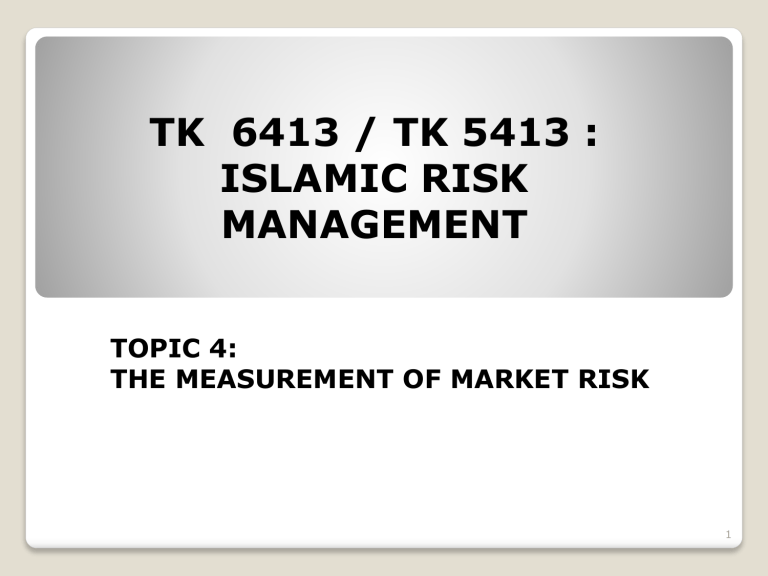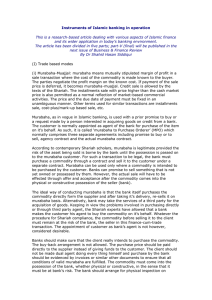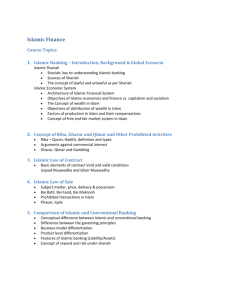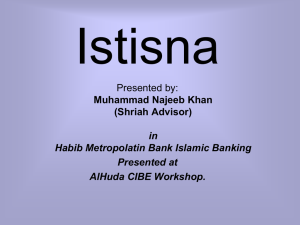to view the attachment

TK 6413 / TK 5413 :
ISLAMIC RISK
MANAGEMENT
TOPIC 4:
THE MEASUREMENT OF MARKET RISK
1
(I) IDENTIFICATION OF MARKET RISK FACTORS
• The four types of risks that expose financial institutions to market risk are: i.
Rate of return (mark-up) or benchmark rate risks related to market inflation and interest rate; ii. Commodity price risks because, unlike conventional banks, they typically carry inventory items (predefined prices); iii. FX rate risks in the same way as conventional banks; iv. Equity price risks, mainly in regards to the equity financing through the PLS modes.
2
Rate of Return
Risk
Murabaha
Ijarah
Salam
Istisna
The Four Types of Market Risks That Exist in the different
Islamic Financial Products
Market Risk
Commodity
Risk
Murabaha
Salam
Istisna
FX Rate Risk
Murabaha
Ijarah
Salam
Istisna
Mudarabah
Musharakah
Equity Risk
Mudarabah
Musharakah
3
(II) RATE OF RETURN RISK
• Murabaha financial contracts – repayment of installment (include price of commodity together with institutions ‘profit’);
• Ijarah leasing contracts – corresponds to actual market price;
• Salam and istisna contracts – price of commodity in respect to the future delivery date, based on the estimated benchmark rates.
• Islamic financial contracts that have fixed income assets driven by rate of returns cannot be adjusted in regards to changes in the benchmark market rates; as a result, financial institution that provide such contracts are facing risks arising from the movements in the market interest and inflation rates.
4
a) Market yield curves
• The market yield curve provides information about the market future expectations illustrated on a graphical representation of the yields for a range terms to maturity.
The yield curves are considered to be a predictor of future economic activities and may provide signals of pending changes in economic fundamentals.
b) Types of yield curves
• There are mainly four types of yield curves that can be used to define market behaviors and are driving the market parameters of Islamic financial contracts; i.
The Normal yield curves; ii. The Steep yield curves iii. The Flat and Humped yield curves iv. The Inverted yield curves
5
c) Applying Yield Curves
• One of the very important factors in determining a yield curve is the currency in which it is denominated; moreover, the economic situation of the countries and companies using each currency is a primary factor that should be considered in determining the yield curve; thus financial institutions and investors that are dealing with Islamic financial contracts and agreements may combine different types of yield curves by considering the expected economic and market conditions.
• For example: i.
During recession – inverted yield curve; ii. Istisna contracts – steep yield curve; iii. Murabaha & Ijarah contracts – upward sloping asymptotically with a positive slope;
6
d) Valuation Based on Rate of Return Risks
• The valuation formula:
P
i n
1
1
CF y m t
• Where P = y n
CF (t) = m =
=
= price and/or profit of the financial instruments; the cash flow at time t installment payment per year yield to maturity total number of periods
7
(III)COMMODITY RISK IN ISLAMIC FINANCE
Influence
Rate
Risk
Quantity
Risk Future
Delivery
Risk
Commodity
Risk Price
Risk
Invert
Price
Risk
FX Rate
Risk
Cost
Risk
8
• Commodity risk is the risk arising from the movement of commodity prices; in Islamic finance, contracts that deal with purchasing commodities and/or their production are exposed to commodity price risk; d) Drivers of the Commodity Risk
• Price Risk:
• Commodity price risk affects consumers and end-users such as manufacturers, governments, processors and wholesalers; it also affect commodity producers; it influences production and business revenues and thus the decision making; there are several factors that affect the price of the commodities and this includes:
⁻ Expected level of inflation;
⁻ Exchange rates;
⁻ General economic conditions;
⁻ Cost of production;
⁻ Ability to deliver on time;
⁻ Availability of substitutes;
⁻ Weather conditions;
⁻ Political stability
9
• Cost Risk:
The cost of manufacturing the commodity is an additional input risk that should also be considered; in Istisna contracts, the manufacturing or construction of assets are directly affected by the cost of raw materials and other production costs;
• Market’s Influence Rate Risk:
Market’s influence is directly influenced by the commodity price where they need to be harmonized in proportion to this rate; in the case of Murabaha – price of the commodity at the maturity date of the repayments; in Salam and Istisna contracts, bank are exposed to market influence rate since the commodities are purchased in advance;
10
• FX Rate Risk:
In the case of Istisna and Salam contracts, the bank may agree to purchase a commodity from the domestic market and make an agreement on selling it to a foreign market; in this case , the trade uses more than one currency and thus is exposed to FX rate risk;
• Quantity and Time Risk:
This is related to the capability of the manufacturer to produce the planned amount of commodities at a specified period. Istisna contracts may expose the bank to a high degree to this type of risks. On the other hand, the market demand for the commodity on different time periods may influence the quantity that should be produced;
11
• Future Delivery Risk:
The Salam contract agreement allows the purchaser to lock in a price, thus protecting the purchaser from price fluctuation.
However, the price of the commodity at the delivery time may be different from the market price and thus the financial institution is exposed to commodity price risk. In istisna sale, the price is paid in advance at the time of the contract and the object of sale is manufactured and delivered later. However, any failure from the seller to deliver on time may cause commodity risk with significant losses;
12
• Inverted Price Risk:
There are occasions when the market is following specific commodity price structures.
This may appear when the demand for cash, by the seller, or near-term delivery, by the purchaser, of a commodity exceeds supply, or even when there are supply problems; then an invert or backwardation market may result. Such types of commodity risks affect both the Salam and Istisna contract agreements;
13
(V) EQUITY PRICE RATE
Equity price risk in regards to Islamic financial contracts is the risk that the financial institution is exposed by its investments’ depreciation as a result of business or market dynamics that are causing losses. The Mudharabah and Musharakah contracts may result in equity price risks.
(VI) VALUATION ISSUES ON EQUITY PRICES AND FX RATES
• The main drawback of equity models is that it is difficult to quantify the level of dividends on a perpetual basis, even on a profit and loss sharing model applied for Islamic finance; based on the valuation models, not all inputs are known or cannot be somehow estimated;
• There are several micro-economic and macro-economic factors that cannot be easily modeled and drive the prices of FX rates;
• Both risk factors, namely equities and FX rates, are liquid-traded financial products and their distributions of returns do not exhibit gaps.
14
VII. QUANTIFICATION OF FX RISK, EQUITY RISK AND COMMODITY RISK
• The quantification analysis and valuation of rate of return risk must consider a higher number of market factors and are modeled by future yield curves;
• For FX risks, every percentage of change in FX rates affects the price of the position with the same percentage. Thus, their evaluation is rather simply applied for generic cases where most of the Islamic financial contracts are classified;
• The equity price may be fixed in Diminishing Musharakah contracts, however, any last equity price and exit of the partnership is based on the market price of the equity; Equity appear to have quite smooth distributions of returns and they can efficiently substitute for any valuation models.
• The quantification of the commodity risk which is arising from the movements of the commodity’s prices should be based on these prices.
The behavior of the commodity price risk can be very similar to that of equities, especially in the case of specific risks.
15
(VIII) DATA REFERRING TO MARKET RISK FACTORS
• Islamic financial products carry more than one market risk factor; moreover even a simple portfolio usually contains different types of contracts. This combination of risk factors and contracts increases the complexity of collecting and combining the information needed for market risk analysis.
Most of the movements can be easily picked up from organized exchanges; however, several risk factors cannot be directly observed in the market place and should be calculated by using other sources of information.
• Market data such as prices referring to Islamic products and agreements are exchanged directly or indirectly at regular points in time. In the Islamic financial contracts, the different points in time that are mainly considered for trading market data used during market risk analysis are the ones that refer to the contracts’ agreement date and the delivery dates.
16
• In general, the more complex the synthesis of the portfolio or balance sheet accounts constructed by Islamic products, the higher the number of risk factors involved and the higher the amount of data needed from the associated databases. It is important to highlight that the trading processes during the lifetime of Islamic financial products is less dynamic than conventional financial products.
• There are many problems arising during this data extracting process; financial institutions are mainly using the ETL systems that are transferring the information from the core database to the risk management system. Errors in information data may result in an under-or-over-estimation of the volatility and thus will affect the measurement of the Value at Risk (VaR)
17
IX. SENSITIVITY IN MARKET RISK
• Sensitivity is a significant factor that plays a critical role in the market risk analysis. Sensitivity to market risk in Islamic products reflects the relationship between the cause from a financial risk factor and its adverse impact to the financial institution’s earnings from these contracts. The causes are initiated from the volatility in risk factors arising in Islamic financial contracts.
• In market risk analysis, the volatility of the risk factors is transformed into market risk by either linear or non-linear means that is encompassed into a unique measure, called market sensitivity.
Thus, every change in risk factors has an equal quantitative percentage effect on the total position invested in the product.
• Thus, integrating the sensitivity and volatility factors, therefore,
Market Risk = (Sensitivity) x (Volatility)
18
X. MARKET RISK VALUATION MODELS
• There are two types of analysis for valuating the market risk.
i.
Static analysis ii.
Dynamic analysis
• Using the static analysis , no change in positions related to financial contract is taken into account; however, the only element that might vary is the market conditions;
• The dynamic analysis is a forward-looking analysis based on defined market price scenarios, business strategies and customer behaviors.
The market positions are moving over time and the prices are always influenced by the customers’ behavior. Market prices are driven by the rules of the market and such rules have to be considered in financial risk analysis. Dynamic analysis is a strong tool for planning the future business in regards to what and how the bank should provide its Islamic financial contracts so that hey can be profitable to the institution and beneficial to its clients.
• Both static and dynamic simulation plays a key role in risk management and institutions must be able to perform both types of analysis.
19
XI. VaR MODELS FOR ISLAMIC FINANCIAL CONTRACTS
• In VaR model analysis, both the position data and the market data are used and the figure below shows the process flow of market and position data for implementing the VaR approach that finally results in the risk evaluation analysis reports.
Market risk factors commodities, FX, equity, benchmark, yield curve movements
Portfolio exposure
Positions of the institutions
(Islamic Financial Products)
Value at Risk mechanism
Risk evaluation reports
20
• Having both position and market data, every VaR mechanism, implicitly or explicitly, is driven by the selection or estimation of the components as shown below and includes the assumptions for the data distribution, the window length of the data used for parameter estimates, the confidence level, the holding period that defines the time horizon for holding the investment, and the individual volatilities and co-movements between or among risk factors defined by using return time series.
21
Main Components considered in VaR models
Distribution assumptions
Window length
Value at
Risk
Volatilities
And
Co-movements
Confidence
Level
Holding
Period
22
XII. POSITION AND MARKET DATA
• For the implementation of the VaR model, that are two classes of data that should be carefully used and assessed: position data and market. Position data is defined within the systems that map the performance of contracts in the institution’s accounts or portfolio. However, market data is usually done by using either interpolation techniques or extensive methods.
• The following are the various interpolation techniques that can be used: i. Linear interpolation; ii. Exponential interpolation; iii. Cubic spline interpolation;
• Each of the interpolation techniques can be applied according to the data availability, and the level of approximation.
23
XIII. POSITION RISK AND EXPOSURE RISK
• In the VaR analysis, there is a strong assumption that the synthesis of the portfolio remains unchanged throughout the holding period. Thus, in the construction of the portfolio, risk managers must be aware that, during their
VaR analysis, the portfolio should remain steady.
• Under the above assumption, the set of market risk factors remains the only source of risk. Thus, i.
The market factors that drive the value of commodities in the
Murabaha, Salam and Istisna contracts are commodity prices; ii.
The main factors that drive the FX in all Islamic financial products are the FX rates; iii.
The factors that drive the equities in the Musharakah and
Mudarabah contracts are the equity prices; iv.
The factors that drive the rate of returns in the Murabaha, Ijarah, salam and Istisna financial contracts are the yield curves.
24
XIV. EVALUATION METHODS OF MARKET RISK
• The three alternative quantitative evaluation methods are: i. The Variance-Covariance approach (VC); ii. The Monte Carlo approach (MC); iii. The Historical-Simulation approach (HS);
• These three approaches can be used to quantify Islamic financial products by deriving the distribution of the changes caused in the value of a portfolio at the end of the holding period. In most cases, in market risk analysis, this distribution appears to be nearly symmetric and is often approximated as normal which may allow for analytical solutions to be developed.
• The VC and MC methods are based on parametric estimation, while the HC method is based on non-parametric estimation.
25
XV. VARIANCE – COVARIANCE METHOD
• The variance – covariance method is applied when there is the assumption that the risk factors follow a multivariate normal distribution and they exhibit serial independence. This method is suitable for Musharakah and Mudarabah contracts where there are cash earnings/profits; this method could be in Murabaha and
Ijarah contracts where the market values may vary from the actual payment installments.
• The key parameter for VaR estimation under variance – covariance method is the measure of volatility. Note that, in order for the volatility to be estimated, it is essential to determine the time series of the prices on returns for each of the contracts that are under consideration. The concept of volatility, is approximated by the variance or standard deviations of returns
26
a) Equally – weighted historical volatility:
it
T
1
1
t
1 s t
T
R is
it
2
Where,
it
1
T
R i 1
R i 2
......
R iT
27
b) Weighted schemes b) Using the weighted schemes approach, the estimation of
will be as follows, it
it
V
L
s
t
1 t
T a s
R is
it
2 s
t
1 t
T
s
is
2
Where,
s t
t
1
T a s
s
t
1 t
T
s
1
28
Using an alternative way of weighted schemes is the exponentially – weighted moving average model (EWMA) produces,
it
1
s
1 t
t
T
t
s
1
R is
2 c) Variance – covariance matrix and VaR
• One of the main elements in constructing the variance-covariance method is the estimation of variance – covariance matrix.
The elements of this matrix classify the possible co-movements among the spectrum of the unitary VaR estimates as they are addressed by the pair-wise correlations formulated below,
ijt
ijt it
2 jt
ijt
2
T
1
1
1 s t t
T
R is
it
R js
jt
29
Where
ijt
ijt is the correlation between asset I and j at time t and is the covariance between asset I and j at time t.
Note that the estimation of covariance according to the Risk Metrics approach is,
ijt
2
1
s t
t
1
T
t
s
1
R is
it
R js
jt
The portfolio’s VaR is estimated,
VaRp
T x C
x
Where,
C =
.
ρ
1.1
ρ
2.1
.
.
ρ n.1
ρ
1.2
ρ
2.2
……. ρ
1.n
……. ρ
2.n
ρ n.2
……. ρ n.n
x
VaR
1
VaR
2
…………
VaR n
30
XVI. MONTE CARLO SIMULATION METHOD
• The Monte Carlo simulation is applied when, on a portfolio, the risk factors have a high degree of non-linearity. Based on different mathematical approaches, the changes in risk factors can be simulated.
• The Monte Carlo simulation is far the most powerful method to compute
VaR and is able to account for wide range of exposures and risks, including non-linear price risk, volatility risk and even model risk.
XVII. HISTORICAL SIMULATION
• The historical simulation method provides a straightforward implementation of full valuation. The underlying methodology consists of going back in time and applying current weights to time series of historical asset returns involved in t he computation of VaR where,
R
i
N
1
i , t
R i , k
31
• The main characteristics of the historical simulation method are that it is the most cost-effective and least consuming approach in terms of computational needs. This methods is relatively simple to implement as long as there is availability of historical data represented mainly in time series.
XVIII. BACK-TESTING AND STRESS-TESTING FOR MARKET RISK
EXPOSURES
• The different methodologies for applying the VaR models to portfolios that contain Islamic financial products should be tested by the financial institutions to evaluate their efficiency and applicability.
32
• When structural changes are taking place in the nature of the portfolios, financial institutions must also test the efficiency of the
VaR model by periodically performing back-test; the back-test is applied to check whether the VaR predictions correspond to observed market changes;
• Moreover, institutions that provide Islamic financial products should also check their vulnerability in extreme circumstances that conventional VaR fail to predict. As these extreme market events may be catastrophic for the institution, their consideration and analysis have significant degree. Therefore, financial institutions should conduct regular stress-tests along with result produced by VaR models.
33









